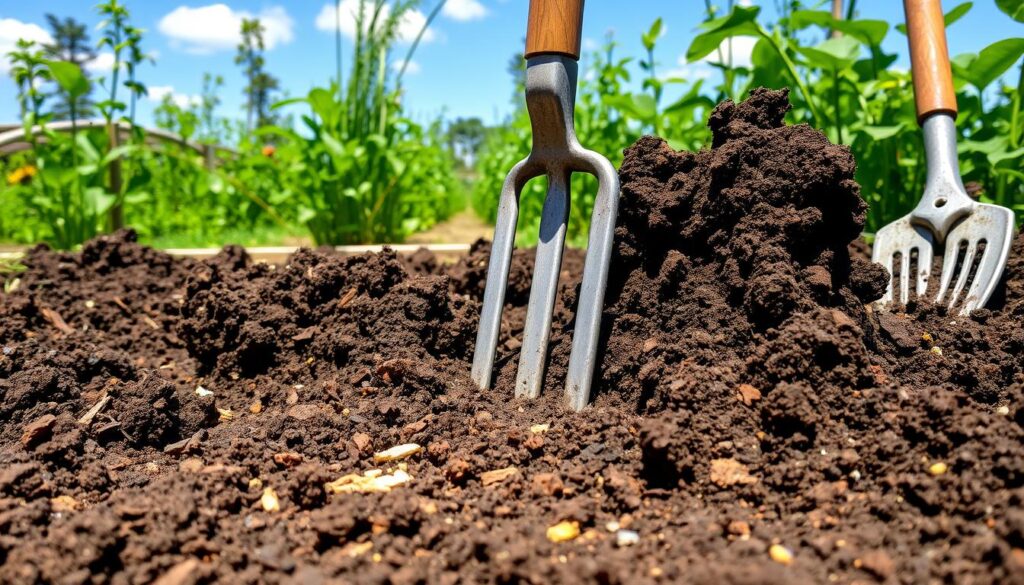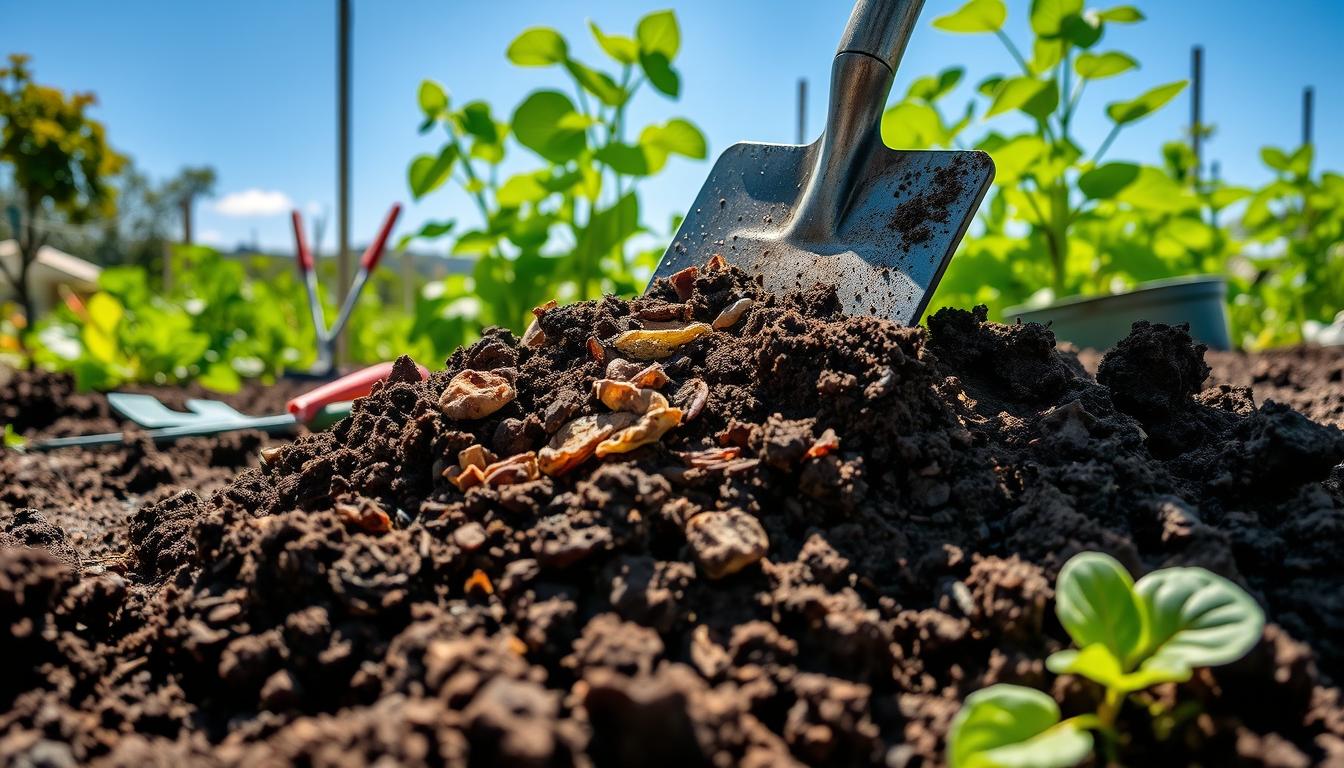Getting your soil ready is key to a great vegetable garden. I’ll show you how to make your soil fertile and full of nutrients. This will help your veggies grow strong and healthy. We’ll cover testing, amending, tilling, and mulching to get your garden started right.
Key Takeaways
- Understand the importance of soil health for a thriving vegetable garden
- Learn how to test and analyze your soil to identify any nutrient deficiencies
- Discover the best methods for amending the soil, including adding organic matter
- Explore the benefits of tilling and cultivating the soil for optimal plant growth
- Discover the advantages of raised bed gardening and how to create them
Introduction to Soil Preparation
Starting a thriving vegetable garden begins with soil health. Healthy soil is key for growing nutritious food. Knowing the basic soil components helps gardeners prepare their beds well.
Importance of Soil Health for Vegetable Gardens
Soil health is vital for growing veggies. It offers the nutrients, moisture, and support plants need to grow. Healthy soil also boosts beneficial microbes, which enhance soil fertility.
This leads to healthier, more productive plants. These plants are better at fighting pests and diseases.
Understanding the Basic Components of Healthy Soil
Soil is a complex mix of several key parts: mineral particles, organic matter, air, and water. The best garden soil has a balanced mix of these. This mix creates the perfect environment for veggies to grow.
- Mineral Particles: Sand, silt, and clay give structure and nutrients.
- Organic Matter: It’s from decomposed plants and animals. It boosts fertility and water retention.
- Air: It’s needed for root breathing and microbial activity.
- Water: It’s essential for plant growth and nutrient transport.
Knowing the importance of soil health for vegetable gardening and the basic components of healthy soil is crucial. It’s the first step to a successful garden. By focusing on these elements, gardeners can ensure their veggies thrive.
How to Prepare Soil for Planting Vegetables
Preparing the soil for vegetables is key to a great garden. A few simple steps can make your plants thrive. Let’s explore the important steps for steps to prepare soil for vegetable planting.
First, test your soil’s pH levels. Most veggies prefer a pH between 6.0 and 7.0. If it’s off, you’ll need to adjust it. This ensures your plants get the nutrients they need.
Then, add organic matter to the soil. Preparing soil before planting vegetables means adding compost or manure. This boosts the soil’s ability to hold water and gives your plants nutrients.
- Test the soil pH and adjust as needed
- Add organic matter to improve soil structure and fertility
- Loosen the soil through tilling or forking to aerate it
- Level the soil surface to ensure even water distribution
- Create raised beds or mounds for improved drainage
After amending, loosen the soil with tilling or forking. This helps roots grow well. Make sure the soil is level for even water.
Lastly, think about using raised beds or mounds. This soil preparation techniques for vegetable gardens helps with drainage and root growth. With these steps done, your garden is ready for planting and a great harvest.

“The key to a thriving vegetable garden starts with the soil. By taking the time to properly prepare and amend the soil, you’re setting your plants up for success from the very beginning.”
Soil Testing and Analysis
Gardening is a rewarding hobby, but the success of your vegetable patch hinges on the quality of your soil. Before you can begin amending your soil, it’s crucial to understand its current state. This is where soil testing and analysis come into play.
Understanding Soil pH Levels
The pH level of your soil is key for healthy vegetable growth. Most vegetables thrive in a pH range of 6.0 to 7.0. If your soil’s pH is off, it can block nutrient uptake, causing stunted growth and low yields. Testing your soil’s pH helps you know if you need to adjust it for better growing conditions.
Identifying Nutrient Deficiencies
Soil testing also shows nutrient deficiencies in your garden. Nutrients like nitrogen, phosphorus, and potassium are vital for plant health. But, their levels can drop over time. By identifying nutrient deficiencies, you can add the right amendments to feed your vegetables well.
Getting a detailed soil test is the first step to a great harvest. Knowing your soil’s pH and nutrient levels lets you make smart choices. You can then take steps to create the perfect growing space for your vegetables.
Amending the Soil
Getting your soil ready for a vegetable garden is key to a great harvest. Adding organic matter is a top way to do this. It makes the soil better and gives your veggies the nutrients they need to grow well.
Adding Organic Matter for Improved Soil Structure
Adding compost, manure, or leaves to your soil can really help. These materials improve soil structure, hold more water, and help good bugs grow. By adding organic matter to vegetable garden soil, you’re improving soil structure for vegetable growing and helping your plants grow strong.
To amend soil for a vegetable garden, mix in 2-4 inches of organic matter. This should be spread over the top 6-8 inches of soil. This way, your veggies can get the nutrients and structure they need to grow well.
| Organic Matter | Benefits |
|---|---|
| Compost | Improves soil structure, increases water-holding capacity, and provides a wide range of essential nutrients. |
| Aged Manure | Adds organic matter, increases nutrient availability, and enhances soil texture. |
| Decomposed Leaves | Improves soil structure, increases water retention, and provides a slow-release source of nutrients. |
By amending the soil with organic matter, you’re taking a big step towards a successful garden. This simple action will help your garden grow strong and give you lots of food.
Tilling and Cultivating the Soil
Preparing your vegetable garden’s soil is more than adding amendments. It’s also about tilling and cultivating the ground. This makes the perfect seedbed for your plants. By using the right tilling techniques and cultivating the soil, you can make sure your garden is ready for a great harvest.
Tilling the soil means loosening the top layer and mixing in amendments or organic matter. You can use a rototiller, spading fork, or garden hoe for this. But, be careful not to overwork the soil. This can cause compaction and poor drainage.
- Start by lightly tilling the top 6-8 inches of the soil. Be careful not to dig too deep and disrupt the soil structure.
- Work in any compost, manure, or other organic matter you’ve added. Make sure it’s evenly distributed.
- Use a rake or cultivator to break up any large clumps. This creates a smooth, level surface.
Cultivating the soil is the next step in preparing your garden beds. This involves loosening the soil to a depth of 2-4 inches. It improves aeration, water infiltration, and root growth for your vegetables.
- Use a garden fork, cultivator, or hoe to gently loosen the soil. Be careful not to disturb the underlying layers.
- Work the soil in multiple directions. This creates a loose, crumbly texture.
- Avoid walking on the cultivated soil. Walking can compact it and undo your hard work.
By tilling and cultivating the soil, you’re preparing your vegetable garden for success. A well-prepared seedbed gives your plants the best conditions to grow. This means a bountiful harvest for you.
Creating Raised Beds for Better Drainage
Raised garden beds can change the game for vegetable gardeners. They offer many benefits that can make your garden better. You can get better soil drainage, improve soil quality, and create a great place for your plants to grow. We’ll look at the good things about raised bed gardening and show you how to make your own.
Benefits of Raised Bed Gardening
Using raised beds can make your vegetable garden healthier and more productive. Some key benefits include:
- Soil drains better, preventing waterlogging and helping plants grow well
- Soil quality gets better with organic matter, adding nutrients and improving texture
- It’s easier to get to your garden, reducing soil compaction and weed growth
- It warms up the soil earlier in spring and keeps it warm longer in fall
- You’ll get more and healthier crops because of the better growing conditions
Building Raised Beds Step-by-Step
Making your own raised garden beds is easy and can fit your needs and space. Here’s how to start:
- Figure out the size and where to put your raised bed. Think about space, sunlight, and how easy it is to get to.
- Build the frame with cedar, redwood, or pressure-treated lumber. Make sure it’s level and sturdy.
- Fill the bed with good, nutrient-rich soil. Mix in compost, topsoil, and other organic stuff.
- Level and till the soil to make it smooth for planting.
- Plan out your garden layout. Think about how much space each plant needs and how they work together.
- Plant your veggies, herbs, and flowers. Make sure they have enough room and are planted deep enough.
By following these steps, you can make raised beds that are perfect for growing veggies. Enjoy the benefits of raised bed gardening and get a big harvest.
Mulching and Weed Control
Keeping your vegetable garden weed-free and moist is key. I’ll talk about mulching’s benefits. You’ll learn how different mulches can keep weeds away, hold moisture, and enhance your garden’s conditions.
Types of Mulch and Their Benefits
There are many mulch options for your vegetable garden. Organic mulches like wood chips, straw, or leaves keep soil moist and weeds down. They also improve soil as they break down. Inorganic mulches, such as gravel or landscape fabric, block weeds but let water and air through.
The right mulch for your vegetable garden depends on your needs. Organic mulches need more frequent replacement, while inorganic ones last longer. Mulching is a great way to keep your garden healthy and productive.
| Mulch Type | Benefits |
|---|---|
| Wood Chips | Slow-decomposing, help retain soil moisture, improve soil structure |
| Straw | Readily available, inexpensive, help suppress weeds |
| Leaves | Abundant, nutrient-rich, help improve soil fertility as they decompose |
| Gravel | Long-lasting, effective weed barrier, easy to maintain |
| Landscape Fabric | Durable, suppresses weeds, allows water and air to penetrate |
Choosing the right mulch for your vegetable garden can make it thrive. It’s a low-maintenance way to get a big harvest. Look into the benefits of mulching and pick the best mulch for your garden.

“Mulching is a game-changer in the vegetable garden, helping to retain moisture, suppress weeds, and improve soil health. It’s a simple, yet highly effective way to create the ideal growing conditions for your plants.”
Crop Rotation and Companion Planting
Keeping your vegetable garden healthy and fertile is more than just soil prep. Crop rotation and companion planting are key. They boost soil quality, fight pests, and diseases, making your garden flourish.
The Benefits of Crop Rotation
Crop rotation means changing up the veggies in your garden bed each season. It stops pests and diseases from taking over and adds back nutrients. This keeps your soil rich and productive for years.
The Magic of Companion Planting
Companion planting pairs veggies in a way that’s magic. Some plants keep pests away, while others help their neighbors grow better. For instance, marigolds keep aphids off tomatoes, and basil makes tomatoes taste and smell better.
| Crop Rotation | Companion Planting |
|---|---|
| Prevents the buildup of soil-borne pests and diseases | Deters pests and enhances plant growth |
| Replenishes nutrients in the soil | Improves the overall health and productivity of the garden |
| Ensures long-term soil fertility | Promotes biodiversity and a balanced ecosystem |
Using crop rotation and companion planting makes your garden strong and productive. It will give you plenty of food every season.
“Diversity is the key to a healthy, productive garden. Crop rotation and companion planting are two powerful tools that can help you achieve this.”
Conclusion
In this guide, I’ve covered the key steps to get your soil ready for a great vegetable garden. We talked about why soil health matters, how to test and improve it, and the importance of tilling and crop rotation. These steps will help your garden start strong.
By using the tips from this article, you’ll create the perfect spot for your veggies to grow. A healthy soil is crucial for a good harvest. The effort you put into preparing your soil will make a big difference all season long.
Starting your vegetable garden? Remember a few important things. Test your soil, add organic matter, till well, and rotate your crops. With these tips, you’ll have a productive and lasting garden. Happy planting!



Leave a Reply